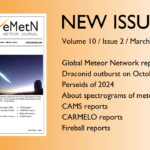Roberto Gorelli points our attention at some recently published meteor related papers.
A New Meteoroid Model
This paper will be published in Earth and Planetary Astrophysics: “A Single Physical Model for Diverse Meteoroid Data Sets.” by Valeri V. Dikarev, Eberhard Grün, William J. Baggaley, David P. Galligan, Markus Landgraf, Rüdiger Jehn.
Abstract: The orbital distributions of dust particles in interplanetary space are inferred from several meteoroid data sets under the constraints imposed by the orbital evolution of the particles due to the planetary gravity and Poynting-Robertson effect. Infrared observations of the zodiacal cloud by the COBE DIRBE instrument, flux measurements by the dust detectors on board Galileo and Ulysses spacecraft, and the crater size distributions on lunar rock samples retrieved by the Apollo missions are fused into a single model. Within the model, the orbital distributions are expanded into a sum of contributions due to a number of known sources, including the asteroid belt with the emphasis on the prominent families Themis, Koronis, Eos and Veritas, as well as comets on Jupiter-encountering orbits. An attempt to incorporate the meteor orbit database acquired by the AMOR radar is also discussed.
You can download this paper for free: https://arxiv.org/pdf/1902.02977.pdf (57 pages).
Lunar impacts
This paper will be published in GERBERTVS: “Lunar impacts during eclipses separated by a Metonic cycle on Jan 21, 2000 and 2019: a possible origin from daytime Sagittarids/Capriconids meteor shower.” by Costantino Sigismondi.
Abstract: The lunar impact claimed by Zuluaga et al. (2019) during the total eclipse of 21 January has been discussed widely by his research group, introducing some results from the technique of gravitational ray-tracing. A similar event of magnitude 6 was observed visually by the author during the eclipse of 19 years before, that was published under the name of “Padua event” (Sigismondi and Imponente, 2000a,b) and a video was obtained independently by Gary Emerson (Cudnik, 2002) in the US at the same time. The remarkable repetition of such a phenomenon after 19 years deserves some investigation about known active meteor shower on Jan 21 with radiant comprised between the solar longitude 300.7° of January 21 and +/- 60° and declination also departing no more than 60° from the solar one. The amount of 60° is the FWHM of a simple modulated probability model on the visibility of a lunar meteor impact with the cosine of the angle comprised between the line of sight and the normal to the lunar surface. The candidate of this search is the daytime shower Sgr/Cap DSC115 with meteoroid velocities around 26 km/s.
You can download this paper for free: https://arxiv.org/ftp/arxiv/papers/1902/1902.03137.pdf (4 pages).
Older meteor library news:
2019
- Lunar impact flashes, by C. Avdellidou and J. Vaubaillon. (10 February 2019).
- The Geminid parent body: (3200) Phaethon, by Patrick A. Taylor, Edgard G. Rivera-Valentín, Lance A.M. Benner, Sean E. Marshall, Anne K. Virkki, Flaviane C.F. Venditti, Luisa F. Zambrano-Marin, Sriram S. Bhiravarasu, Betzaida Aponte-Hernandez, Carolina Rodriguez Sanchez-Vahamonde and Jon D. Giorgini. (10 February 2019).
- Sun approaching asteroids and meteor streams, by Quanzhi Ye and Mikael Granvik. (10 February 2019).
2018
- Waiting to make an impact: A probable excess of near-Earth asteroids in 2018 LA-like orbits, by C. de la Fuente Marcos and R. de la Fuente Marcos. (18 December 2018).
- What mechanisms dominate the activity of Geminid Parent (3200) Phaethon?, by LiangLiang Yu, Wing-Huen Ip and Tilman Spohn. (6 November 2018).
- The Draconid meteoroid stream 2018: prospects for satellite impact detection, by Auriane Egal, Paul Wiegert, Peter G. Brown, Danielle E. Moser, Althea V. Moorhead and William J. Cooke (21 September 2018).
- Modeling the measurement accuracy of pre-atmosphere velocities of meteoroids, by Denis Vida, Peter G. Brown and Margaret Campbell-Brown (15 July 2018).
2017
- The Mayas and Eta Aquariids in AD 250-909, by J.H. Kinsman and D.J. Asher (31 July 2017).


